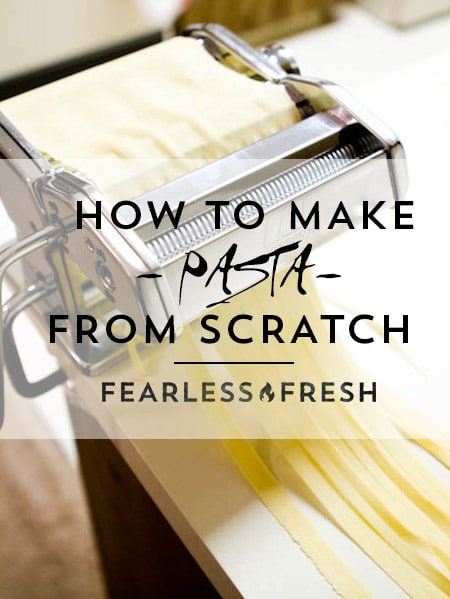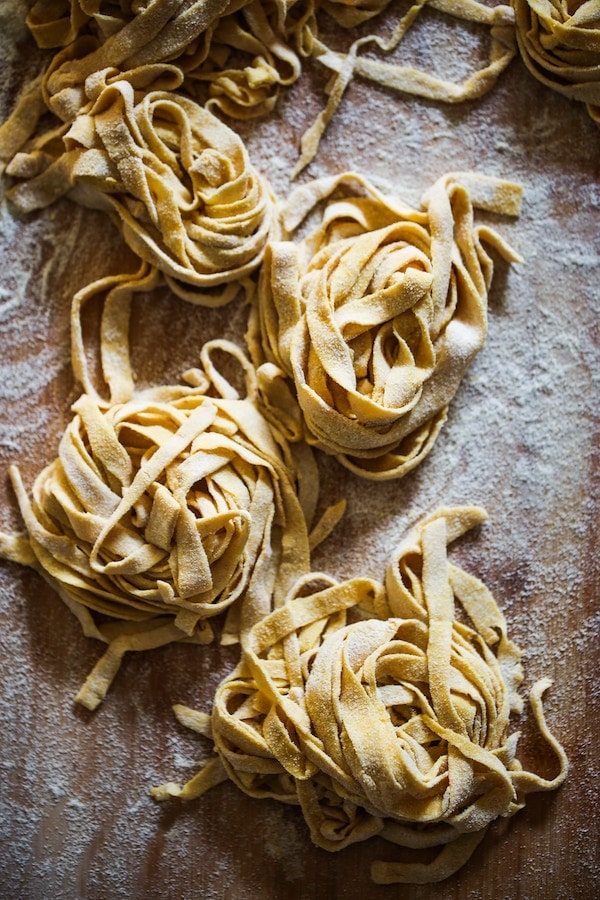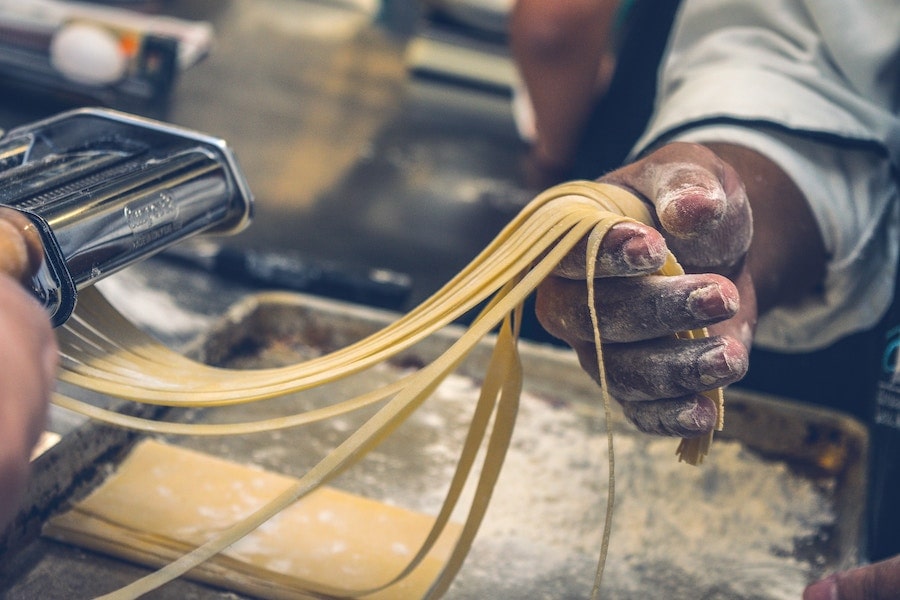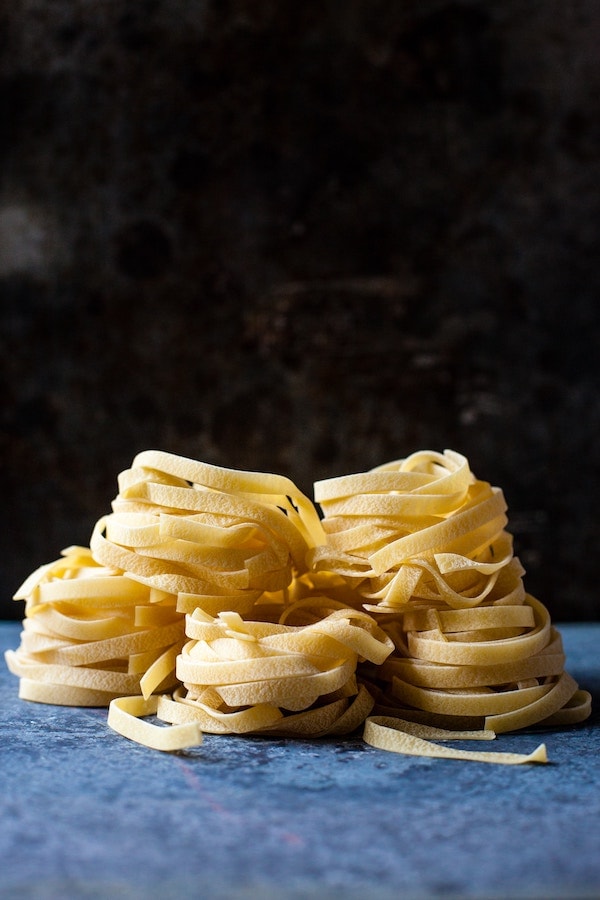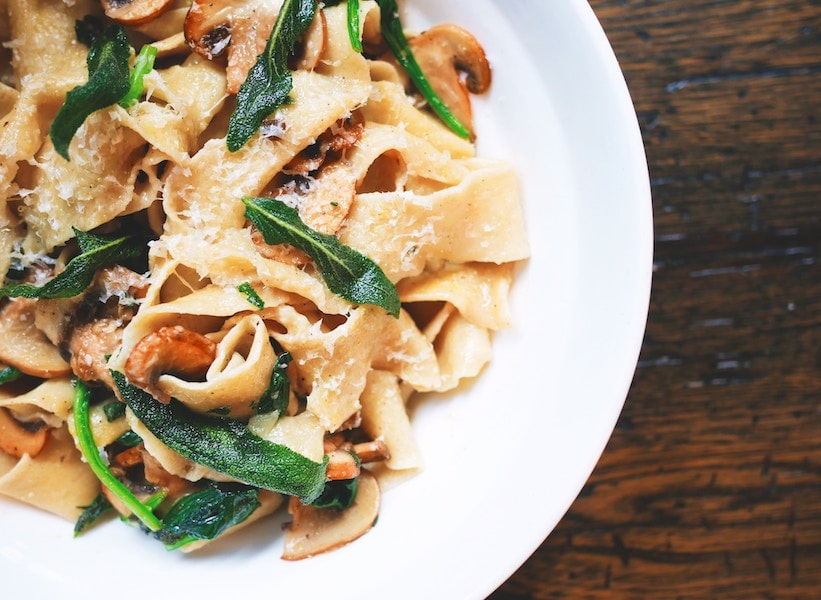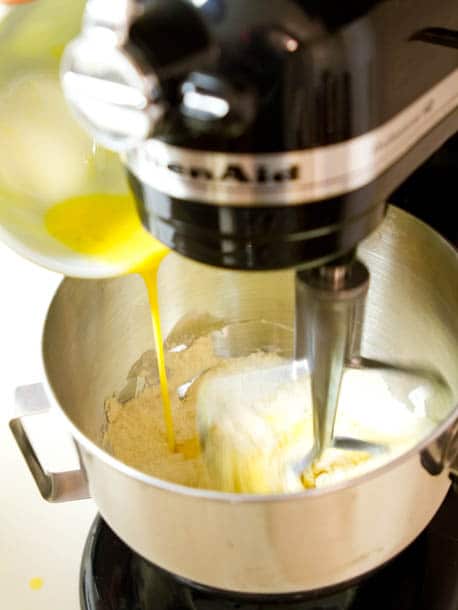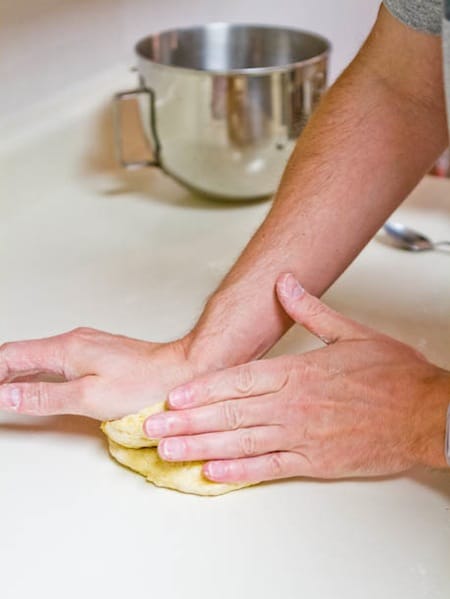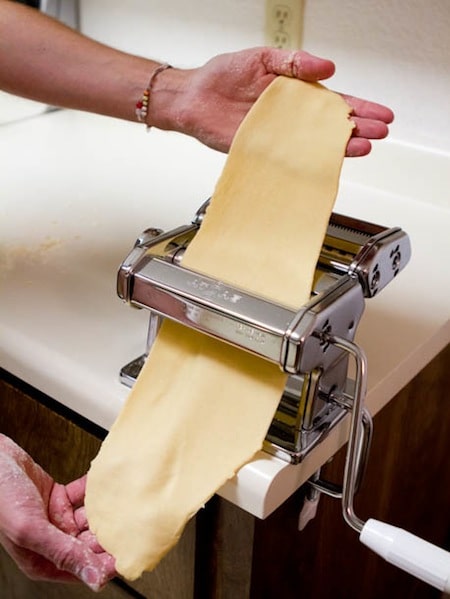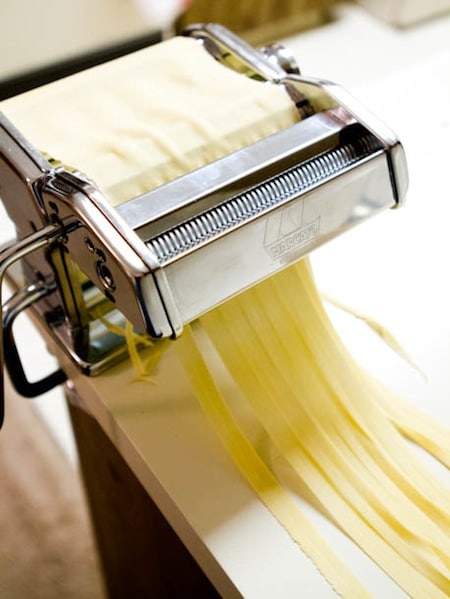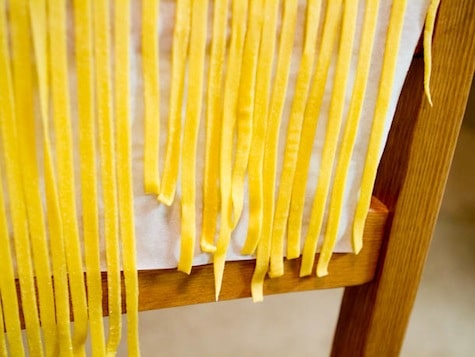– How to make fresh pasta dough, all fresh and homemade-like. –
Learning how to make fresh pasta dough for dinner tonight is incredibly easy, especially when you’ve got a sexy little beast like a pasta machine taking up residence in your cupboard.
I somehow ended up with two of these things, so I thought I should start putting them to good use. Honestly, I can’t think of a more hearty, comforting, home cooked meal than fresh pasta, especially when it’s paired with an awesome artisanal cheese.
I’ve made homemade pasta countless times before, but I’ve always sliced the noodles by hand with my favorite kitchen knife or cut them with a chitarra, a wire-based pasta cutter that looks similar to the belly of a guitar (chitarra is actually Italian for ‘guitar’).
While I love the mouthfeel of imperfectly rolled, somewhat grainy-textured noodles – which is what you get when you roll pasta by hand – I’ve always been enthralled by the idea of creating an expanse of perfectly smooth pasta sheets.
In order to get the smoothness you’re used to seeing in store-bought pasta, you have to use a pasta machine. And it’s pretty difficult to screw it up. That’s a plus.
If you don’t have a pasta machine, should you buy one? The truth is, you certainly don’t need one. You can easily cut pasta by hand, and it’s actually my preferred method for making handmade pasta because it’s more rustic. That’s just how I roll.
But if you’re looking for someone to convince you to pick up a pasta machine, here are three good reasons: They’re fast, fun, and solid as a rock.
The noodles produced by a pasta machine are almost always perfectly formed and have a luxuriously silky quality, which doesn’t go away after they’re cooked.
So if you plan on making a lot of pasta in the future, or making huge batches to freeze, a pasta machine may be a good investment.
Note: Pasta machines are also useful for rolling fondant and gum paste, so if you plan on making wedding cakes or diving into other types of cake decorating, they’re really handy in this capacity.
How to Make Fresh Pasta Dough – Basic Recipe
Some books are just made for people learning to cook. Many years ago I picked up a copy of Alice Waters’ The Art of Simple Food, and while I’ve sat down and read through the book, I’d yet to actually make anything from it.
It’s a shame, really, because I’ve heard many good things about the dishes in this book; I just hadn’t found the perfect opportunity to put it to use. Now is the perfect opportunity.
Alice’s pasta recipe came off without a hitch and produced nice, thick, strong noodles that didn’t stick terribly, like pasta dough is known to do. It’s a great recipe for those just discovering how to cook fresh pasta.
While her recipe calls for mixing the dough by hand, I used my KitchenAid mixer. I also use half all-purpose flour and half semolina flour, which I’ve found gives the noodles a nice texture that sauce love to cling to.
And what good is a noodle if it can’t hang onto sauce? You could even just cut the noodles into squares and use them for making pot stickers or other dumplings.
What is semolina flour? Semolina is made from coarse durum wheat, giving it more texture than regular all purpose flour. It’s often used to make pasta, couscous, and some breads.
You can usually find semolina flour at many large grocery stores, and certainly at your local Whole Foods. It should be in the baking section, or with the whole grains in the bulk section.
To-do this week: Check out the Ninja Cooking Community on Facebook, where you can get free kitchen coaching from yours truly, and join in the conversation with a bunch of others who are learning and loving cooking (and making it WAY less stressful in the process).
Come get your cooking questions answered, share your experiences, and talk about what to cook for dinner tonight!
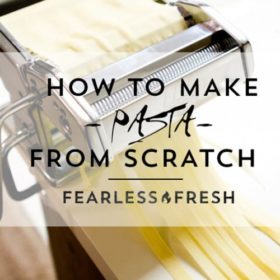
How to Make Fresh Pasta Dough Using A Pasta Maker
Ingredients
- 1 cup all-purpose flour
- 1 cup semolina or durum flour
- 2 eggs beaten
- 2 egg yolks beaten
- 1/2 teaspoon water
Instructions
- First, mix everything together. This takes literally two minutes and almost no effort. Add flours to the bowl of a mixer, hook on the paddle attachment, and turn your mixer to low speed. Slowly pour in the eggs and beat until crumbly, adding a little water if you need to (wetter pasta dough is easier to work with than dry dough). If you don't have a mixer, you can mix the dough in a large bowl, using a fork to start combining the flour and eggs. Finish the dough by mixing with your hands once the mixture is too clumpy for the fork.
- Sprinkle a thin layer of flour on the counter. Turn the dough onto the counter and knead by hand until it just comes together and begins to smooth out, about 2 minutes. Kneading the dough is almost as easy as mixing it. Squish, roll, repeat. The dough will not be perfectly smooth - that's normal.
- Form the dough into a flat disk, wrap it in plastic wrap, and set it in the refrigerator for 2 hours so that the gluten can relax.
- Once it has rested, flatten the disk with your hands so that it is 1-inch thick and sprinkle with a little flour on both sides. Run the dough through the pasta machine with the flat rollers set to their most open setting; fold the dough sheet into thirds, like a letter, and roll it back through the pasta maker again. If the dough sticks, coat with a little more flour. Fold and roll the dough three more times on this setting, which kneads it to produce a silky texture.
- Now it's time to stretch your pasta dough. Keep running the dough through the flat pasta rollers, closing the gap between the rollers one stop every time you roll your pasta through. Use your free hand to guide the pasta as it comes out the bottom of the pasta machine, folding the sheet of dough back over itself to prevent it from piling into a lump that may stick to itself. If your dough begins to stick, sprinkle lightly with more flour. I usually stop at setting 3 or 4, for I find that thinner pasta breaks easily and doesn't have the same hearty mouthfeel that you get with a little extra noodle thickness.
- To cut the noodles into strips, change the attachment on the pasta machine to whichever cutting attachment you prefer, then roll the pasta sheet through the machine. Otherwise, you can also cut the flat sheets of pasta into thin strips by hand, using a long, sharp knife.
- Once the noodles are cut, hang them to dry over a pasta hanger (we just used the back of a chair, draped with parchment). Make sure the noodles aren't touching one another, lest they stick together. Let the pasta dry for 20 minutes or until you're ready to cook them.
- If you want to refrigerate or freeze the pasta, you can spread the noodles on a piece of parchment and store them in a sealed bag.
- Now the fun part - eating! Fill a large pot of water and set it to boil. Once it's at a good, rolling boil, add 3 tablespoons of salt and heat for another 3 minutes to bring it back to a boil. Add the noodles and stir frequently to ensure the noodles don't stick together. Cook for 3-6 minutes, or until the pasta has a good bite without tasting of raw flour. Strain through a colander and serve immediately.
Nutrition
This content was originally posted on FearlessFresh.com.

